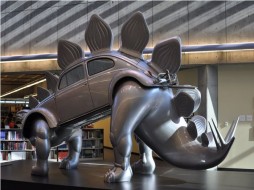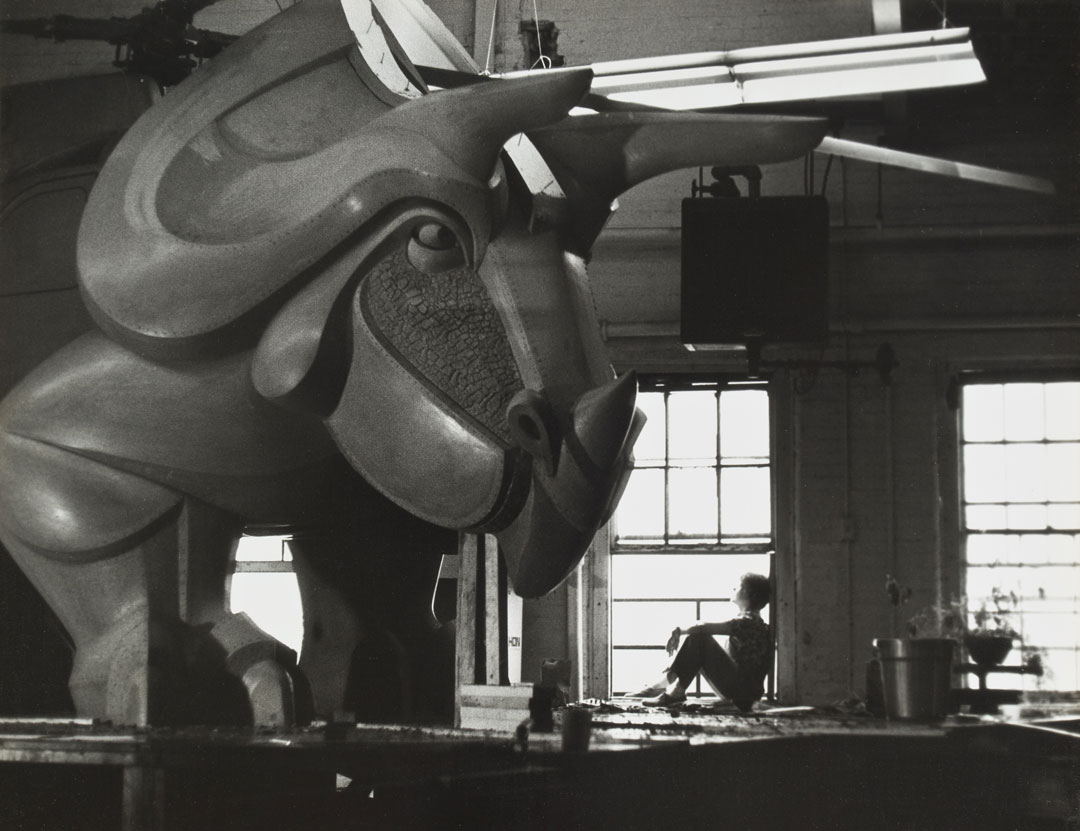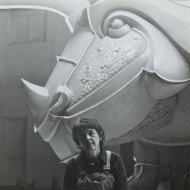by Cedric Rose
As the culminating experience practicum for my Master of Library and Information Science degree, I am working on a digital collection of documents connected to the evolution of Patricia Renick’s Triceracopter: Hope for the Obsolescence of War. The finished library will illuminate the connections and processes–physical, social, and conceptual–concealed in the finished work. Along the way I’ll ruminate on issues and concepts related to digital libraries (DLs).
Triceracopter is a hybrid of parts with far-flung origins in space and time: part three-horned Rhinoceros-like creature that last walked the earth 66 million years ago, part war-damaged helicopter, the final manifestation of a series of forms that imprinted further forms under the hands, intellect, imagination; and will of a DAAP professor and sculptor whose life included shock treatment for a misdiagnosis of schizophrenia (Chapman 2003), decades of teaching art, and emergence as an internationally recognized artist.
In Triceracopter, Renick connects our history and future to the visceral present. Libraries connect us to the past and future, as well as to one another. In a digitally networked world, connections multiply, offering new pathways and applications. Information technology is a great tool for transmitting and receiving information, but it’s also a new tool for thinking, learning, understanding, and creating even as it is also becoming evident that, used as a mere crutch or convenience, such technology also runs the risk of limiting us.
Google, which began as a digital library project (Hart 2004), is now seen by some as a threat to libraries as we know them. Google Book’s ultimate goal, to digitize the world’s books, revolutionizes our ability to access their contents. Library shelves are becoming fluid, endlessly reconfigurable; the covers, pages and sentences in books, transparent. True, libraries as buildings and institutions will no longer hold a monopoly on library collections (and for the future’s sake, Google better not either). But despite talk that libraries will go the way of the dinosaur in a world where all print and media will be searchable online, the opposite is true. The essential function of libraries and librarians: to organize and mediate access to documents, information sources, and media, is as vital today as it was in ancient Alexandria, if not more so because, despite excellent automated tools for sorting and culling search results, the library is expanding exponentially while multifaceted lenses enable ever-finer scrutiny.
What does all this have to do with Triceracopter? While digital libraries, datasets, and digital collections support the mining and visualization of data for essential quantitative analysis and research, they can also support humanistic endeavors: digital libraries compliment studies in Digital Humanities. Digital libraries help users cull relevant results from massive pools of information, but they also offer qualitative experiences. They enhance humanistic exploration. In Triceracopter, Renick speaks about our relationship with machines. There’s a cold logic to machines, especially those used to kill. Renick’s own M.O. extended beyond logic. Interviewed by writer Laura Chapman, who asked whether she “approaches her work with a mathematical mind”, Renick responded “Everything is intuitive” (Chapman 2003). Our forays into digital technology should accommodate both the logical and the emotive, the intuitive and the creative.
So why a Triceracopter Digital Library? Because I’m interested in those aspects of digital libraries that support the humanities, including art. Because there are connections nested in this Bicentennial Baby worth sorting out. The portion of Renick’s papers that deal with the creation of this work show its political and historical connections. America exited Vietnam in 1975 (by helicopter, no less). Renick’s earlier work showed her fascination with the juxtaposition of the biological and the mechanistic. And works like Stegowagenvolkssaurus, a Stegosaurus with a Volkswagon Beetle torso, currently on display in NKU’s Frank Steely Library, also playfully embody cultural issues . . . and warnings. These artifacts connect earlier eras to our own. To the archaeologist, to the paleontologist, and even to the futurist and the archivist, no detail is too small. Even the artist’s formal communications as she works through bureaucracies might reveal something new about her determination, rationale, and voice.

Stegowagenvolkssaurus, also by Patricia Renick, at the Steely Library at Northern Kentucky University.
In art, our experience of the finished product can and certainly should be enough. But this shouldn’t preclude further investigation, going deeper. Digital collections enable us to more deeply access the analog collections from which they are created, to take in larger relationships, and to examine with the finest possible lens their content’s intricacies. Or simply to discover. There are many narratives within Triceracopter’s story, in the photos of its creation, Renick’s communications with the U.S. military, chemical corporations, government bodies, academic and arts organizations, and individuals. And there’s also the all-too human drama of the artist’s location at the center of a web of tensions: taut strands between the creative impulse and the demands of work, between necessity and the fight for time, for space, for money and materials, for the skills and techniques, and even that most fundamental of artistic struggles: the overcoming of both criticism and self-doubt, to create.
References
Chapman, L. H. 2003. “No Time for Second Thoughts: A Conversation with Patricia A. Renick”. Sculpture. 22: 38 43. Par. 30 & 46 Retrieved from http://www.sculpture.org/documents/scmag03/oct03/renick/renick.shtml
Hart, David. August 17, 2004. “On the Origins of Google,” National Science Foundation. Retrieved from http://www.nsf.gov/discoveries/disc_summ.jsp?cntn_id=100660



